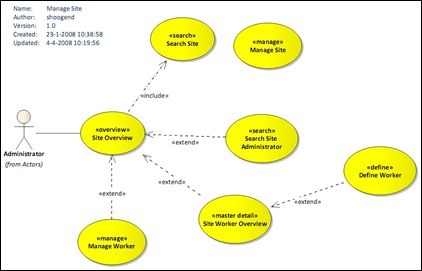As you might have heard from me before (endlessly), smart use cases are a fairly straightforward reqirements technique that we have introduced in many different types of projects.
Of course, Java, .NET, BI projects apply smart use cases, but this year I have also been involved in service oriented projects, where smart use cases where used to model not only the front end but also the services and the workflow. Works smoothly. The developed system has been in production since December 1 and is running fine.
At times I receive questions around the use of smart use cases in projects, this time from Belgium, by Erwin Bauwens. I’ll try to translate. See Erwin’s original Dutch version of the questions below.
Erwin: Now there’s an opportunity to apply smart use cases in a project. This brings forward some questions.
When estimating the complexity of smart use cases, is an estimate only produced based on the sub-function level use cases (at lower granularity), and is the complexity of the user-goal level use case merely the aggregate of these points?
Extracting sub-function level use cases from a user-goal level use case is NOT a functional decomposition. The single user-goal level use case always performs some part of the works. At least it’s responsible for co-ordinating the whole process it implements, but in most cases it also will own part of the user interface, like in the example below where user-goal level use case Site Overview show all information on the managed site.

An example smart use case diagram
Thus, it has the same level of granularity as the underlying sub-function level use cases. And it is also estimated using the same scale (1..5, 8, 10) as the sub-function level use cases. The total complexity of the diagram then is the aggregate of the weights of ALL use cases in it.
To follow the presented example, use cases Site Overview is probably rated as a 3 – Average on the smart use case scale. I would estimate the total diagram at 22 smart use case points, including the 3 from Site Overview.
Erwin’s original question
Maar nu dient er zich toch een gelegenheid aan om de “Smart Use Case” methode wat meer in de praktijk te brengen ! Alleen ben ik wat bang dat ik er toch niet genoeg over weet. Zo heb ik nu al concreet enkele praktische vragen :
Bij het inschatten van de complexiteit van de use cases, wordt de schatting enkel gegeven voor de secundaire use cases (met lagere granulariteit dus), en is de primaire use case de optelsom van de punten die gegeven worden aan de secundaire ?
Met vriendelijke groeten
Erwin Bauwens
One Day Solutions
3 thoughts on “Questions on smart use cases. Part I – Estimating user-goal and sub-function level use cases”
Thanks Sander for taking the time to answer ! Indeed, as I’m experiencing now, the granularity of the primary use case is on the same level as its secundary uses cases, so that works exactly like you said !
Hi Sander
thanks for your prompt answer ! Today I experienced first hand that the primary use cases indeed have the same granularity as the secundary ones, so everything worked out exactly as you said !
Can I just add that following your guidelines beats every other approach I've ever worked with !
So a big tnx !
Erwin
Tnx Sander for taking the time to answer ! Indeed, as my experience now shows, the granularity of primary and secondary use cases are approximatively the same, so everything worked out exactly like you said ! So tnx again !
Comments are closed.